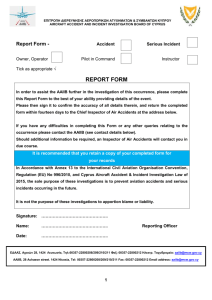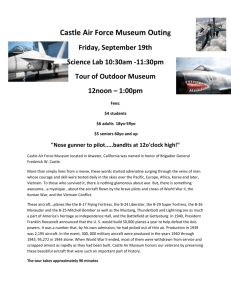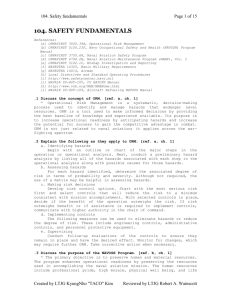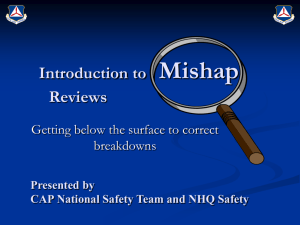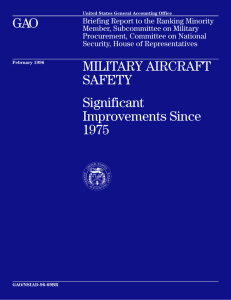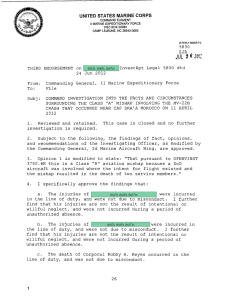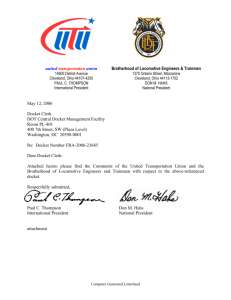Annex V Aircraft Accident or Incident
advertisement
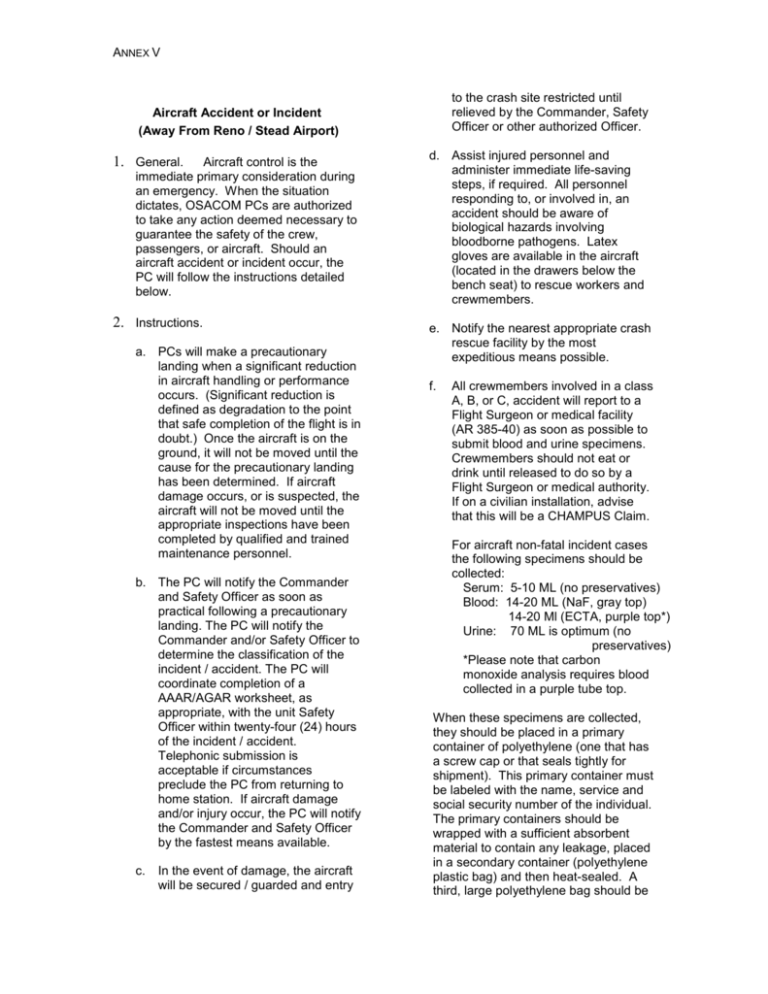
ANNEX V to the crash site restricted until relieved by the Commander, Safety Officer or other authorized Officer. Aircraft Accident or Incident (Away From Reno / Stead Airport) 1. General. Aircraft control is the immediate primary consideration during an emergency. When the situation dictates, OSACOM PCs are authorized to take any action deemed necessary to guarantee the safety of the crew, passengers, or aircraft. Should an aircraft accident or incident occur, the PC will follow the instructions detailed below. 2. Instructions. a. PCs will make a precautionary landing when a significant reduction in aircraft handling or performance occurs. (Significant reduction is defined as degradation to the point that safe completion of the flight is in doubt.) Once the aircraft is on the ground, it will not be moved until the cause for the precautionary landing has been determined. If aircraft damage occurs, or is suspected, the aircraft will not be moved until the appropriate inspections have been completed by qualified and trained maintenance personnel. b. The PC will notify the Commander and Safety Officer as soon as practical following a precautionary landing. The PC will notify the Commander and/or Safety Officer to determine the classification of the incident / accident. The PC will coordinate completion of a AAAR/AGAR worksheet, as appropriate, with the unit Safety Officer within twenty-four (24) hours of the incident / accident. Telephonic submission is acceptable if circumstances preclude the PC from returning to home station. If aircraft damage and/or injury occur, the PC will notify the Commander and Safety Officer by the fastest means available. c. In the event of damage, the aircraft will be secured / guarded and entry d. Assist injured personnel and administer immediate life-saving steps, if required. All personnel responding to, or involved in, an accident should be aware of biological hazards involving bloodborne pathogens. Latex gloves are available in the aircraft (located in the drawers below the bench seat) to rescue workers and crewmembers. e. Notify the nearest appropriate crash rescue facility by the most expeditious means possible. f. All crewmembers involved in a class A, B, or C, accident will report to a Flight Surgeon or medical facility (AR 385-40) as soon as possible to submit blood and urine specimens. Crewmembers should not eat or drink until released to do so by a Flight Surgeon or medical authority. If on a civilian installation, advise that this will be a CHAMPUS Claim. For aircraft non-fatal incident cases the following specimens should be collected: Serum: 5-10 ML (no preservatives) Blood: 14-20 ML (NaF, gray top) 14-20 Ml (ECTA, purple top*) Urine: 70 ML is optimum (no preservatives) *Please note that carbon monoxide analysis requires blood collected in a purple tube top. When these specimens are collected, they should be placed in a primary container of polyethylene (one that has a screw cap or that seals tightly for shipment). This primary container must be labeled with the name, service and social security number of the individual. The primary containers should be wrapped with a sufficient absorbent material to contain any leakage, placed in a secondary container (polyethylene plastic bag) and then heat-sealed. A third, large polyethylene bag should be ANNEX V used to keep all the specimens from one individual together. The blood and /or urine should be packed, unfrozen, in a shipping container of sturdy cardboard, plastic or metal construction and shipped FIRST CLASS to the AFIP. Registered mail and or “Return Receipt Requested” is neither necessary nor recommended. All aircraft incident specimens should individually be accompanied with a properly completed DD Form 1323, including the chain of custody documentation. The following information should be placed on the outside wrapper of all shipments: Armed Forces Institute of Pathology Division of Forensic Toxicology Washington, D.C., 20306-6000 Phone Contacts: Detachment 45 Commander: 775-720-8417 Detachment 45 Aviation Safety Officer: 775-720-0653 OSACOM Safety: 703-806-7005 JOSAC Scheduling: 1-800-256-7609 Ft. Rucker Safety Center: DSN 558-2660/3410/4273 COM 205-255-2660/4273/3410 The PC, having been selected for maturity and good judgment as well as pilot skills, will be expected to use good leadership principles and good judgment in carrying out the tasks listed below. c. With regard to the purpose stated above, the following are PC responsibilities and will be followed in the priority listed: 1. Get all occupants out of the aircraft and safe distance away, preferably in a sheltered area. 2. Administer first aid and/or life saving steps to injured crewmen or passengers. 3. Retrieve survival kits, first aid kits, the log book and map case. 4. Begin using the survival radio per instructions. If an occupied dwelling is known to be nearby, send someone to call for help. 5. Write down the location of the site for the caller. 6. Take charge of the mishap site. 7. Do not allow anyone to disturb any part of the wreckage except for removing incapacitated occupants. 8. Take charge, keep passengers calm and busy. Pilot responsibilities. 1. Assist the PC with the duties listed in “b” above. 2. Retain accountability for the survival kits, first aid kits, and map case. 3. Use and monitor the survival radio. Aircraft Mishap Procedures: Responsibilities of Aviators Involved in an Aircraft Mishap. a. Purpose. To provide general guidance to all aircrew members for establishing a chain-of-command at the mishap scene, preserving life and property, insuring the survival and speedy rescue of all occupants, and the preservation of the mishap scene and critical documents. b. Applicability. Just as no accident is planned, there is no way to predict the actual events and circumstances of a mishap. The directives below assume the worst case even though a mishap with regard to this section could range from a precautionary landing to a Class A mishap. If the PC is incapacitated, the pilot will take command of the mishap site. d. Crewmembers will, to the maximum extent possible, insure that the mishap site is untouched and that no aircraft parts are tampered with or moved. e. If time permits, crewmembers and passengers should write down the facts pertaining to the mishap as soon as possible. This should include: time, conditions (flight and weather), unusual noises, parts or equipment failures, a chronological sequence of events, conversations relating to the mishap, engine readings (if known), emergency actions taken, etc. ANNEX V f. Post-mishap responsibilities: 1. All crewmembers involved in Class A, B, and C mishaps will, upon their return from the mishap site, immediately submit themselves to the nearest medical facility for the purpose of obtaining body fluid samples. 2. The Detachment Commander must either be present or execute a delegation of authority to the facility commander to maintain the proper chain-of-custody for all samples. 3. All crewmembers involved in Class A, B, C, and D mishaps will make themselves available for interviews for the accident investigation board and/or collateral investigations.



